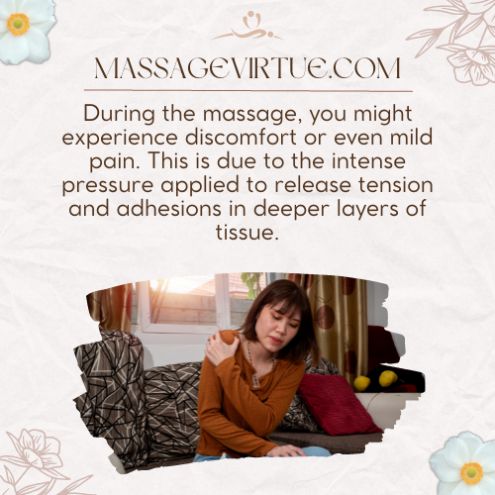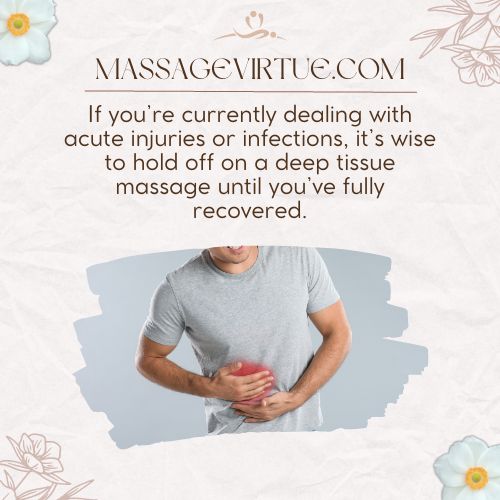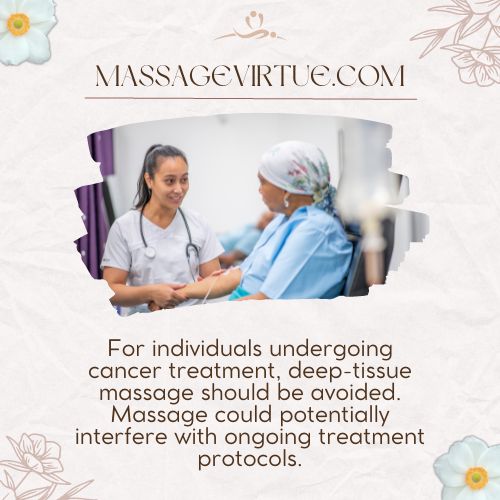Deep tissue massage is a popular type of massage therapy that aims to relieve tension and pain in the deeper layers of muscles and connective tissues.
However, deep tissue massage is not without risks.
In some cases, it can cause serious complications or aggravate existing problems.
In this article, we will explore the potential dangers of deep tissue massage, and how to avoid them.
Side Effects of Deep Tissue Massage
While the intention of deep tissue massage is to provide relief, there are some side effects that people might experience:
1. Bruising after Deep Tissue Massage
Deep tissue massage involves applying firm pressure and friction to the muscles and tissues, which can cause some damage to the blood vessels and capillaries.
This can result in bruising, which may appear as dark or purple spots on the skin.
Bruising usually fades away within a week or two, and does not indicate any serious injury.
2. Temporary Discomfort
During the massage, you might experience discomfort or even mild pain.
This is due to the intense pressure applied to release tension and adhesions in deeper layers of tissue.

While some discomfort is expected, it’s crucial to communicate with your massage therapist if the pain becomes too intense or unbearable.
3. Increased Sensitivity
After a deep tissue massage, your muscles and tissues might be more sensitive to touch. This heightened sensitivity is usually temporary and should subside within a day or two.
4. Soreness
It is normal to feel some soreness or stiffness after a deep tissue massage, especially in the areas that were worked on.
This usually lasts for a day or two and can be relieved by applying ice or heat, stretching, and drinking plenty of water.
5. Headache After Deep Tissue Massage
Some people may experience a headache after a deep tissue massage, due to the release of toxins or tension in the head and neck area.
A headache can also be a sign of dehydration, so it is important to drink enough water before and after the massage.
A mild painkiller can help ease the discomfort.
6. Nausea
A deep tissue massage can stimulate the digestive system and cause some nausea or upset stomach.

This can be due to the pressure on the abdominal organs, or the release of toxins into the bloodstream.
Nausea usually subsides within a few hours and can be prevented by avoiding heavy meals before or after the massage.
What to Do After a Deep Tissue Massage?
To minimize the side effects and maximize the benefits of a deep tissue massage, you should follow these tips after your session:
- Drink Plenty of Water: Water helps flush out the toxins and waste products that are released from the muscles and tissues during the massage. It also helps prevent dehydration and headache.
- Apply Ice or Heat: Ice can help reduce inflammation and swelling in the areas that were massaged. Heat can help relax the muscles and ease soreness and stiffness. You can alternate between ice and heat every 15 minutes for an hour or two after the massage.
- Stretch Gently: Stretching can help maintain flexibility and range of motion in the muscles and joints that were worked on during the massage. You should stretch slowly and carefully, without forcing or bouncing.
- Rest Well: A deep tissue massage can be physically and mentally exhausting, so you should give yourself some time to recover and relax. You should avoid strenuous activities or exercises for at least 24 hours after the massage.
Who Should Avoid Deep Tissue Massage?
Deep tissue massage is not suitable for everyone. There are some conditions that contraindicate this type of massage therapy, meaning that it could cause harm or worsen the situation. Some examples of contraindications are:
1. Acute Injuries or Infections
If you’re currently dealing with acute injuries or infections, it’s wise to hold off on a deep tissue massage until you’ve fully recovered.

Conditions like open wounds, fractures, sprains, inflammation, infections, or fever require healing before undergoing a massage.
Engaging in massage therapy while these conditions are present could exacerbate bleeding, swelling, pain, or even spread infection.
2. Osteoporosis and Fragile Bones
Individuals with osteoporosis should approach deep tissue massage with caution.
The pressure applied during the massage could potentially lead to fractures or cause harm to already delicate bones.
3. History of Blood Clots
If you have a history of blood clots or are at a heightened risk of developing them due to conditions such as deep vein thrombosis or atrial fibrillation, it’s advisable to avoid deep tissue massage.
The massage pressure could dislodge a clot, posing a serious risk if it travels to vital organs like the lungs, heart, or brain.
It potentially leads to conditions like pulmonary embolism, heart attack, or stroke.
4. Cancer Patients
For individuals undergoing cancer treatment, deep-tissue massage should be avoided.

Massage could potentially interfere with ongoing treatment protocols or even facilitate the spread of cancer cells to other parts of the body.
5. Pregnancy and First Trimester
Pregnant women, especially those in the first trimester, should steer clear of deep tissue massage.
The pressure and manipulation involved could potentially induce labor, lead to miscarriage, or pose risks to the developing fetus.
It’s recommended to explore other massage options that are safe and tailored to the needs of pregnant individuals.
Deep Tissue Massage Benefits
Despite the potential dangers of deep tissue massage, there are also many benefits that can outweigh the risks. Some of the benefits are:
| Benefits | Description |
| Pain Relief | Alleviates discomfort in areas like the back, neck, and joints, offering relief from chronic conditions including arthritis and headaches. |
| Improved Circulation | Enhances blood flow and oxygen supply, accelerating healing, lowering blood pressure, and promoting heart health. |
| Reduced Stress and Anxiety | Triggers the release of endorphins, natural mood enhancers, while reducing cortisol levels to ease stress and fortify the immune system. |
| Enhanced Performance and Mobility | Boosts flexibility, prevents post-exercise stiffness, and minimizes injury risks, leading to improved athletic performance. |
Conclusion
At the end of the day, while deep tissue massage offers numerous benefits, it’s essential to be informed about potential side effects and contraindications.
Communicating openly with your massage therapist can help you minimize risks.
Remember, your well-being is paramount, and making an educated decision is the first step toward a healthier you.
FAQs
Are There Risks with Deep Tissue Massage?
Deep tissue massage, while generally safe, can have some risks. These may include temporary discomfort, bruising, and increased sensitivity.
Who Should Avoid Deep Tissue Massage?
People with acute injuries, infections, osteoporosis, blood clot history, or those undergoing cancer treatment should avoid deep tissue massage.
Pregnant women, especially in the first trimester, should also refrain from it due to potential risks.
Why Avoid Deep Tissue Massage?
Avoiding deep tissue massage is important to prevent the worsening of injuries, fractures, blood clot complications, interference with cancer treatment, and potential harm to a developing fetus during pregnancy.
Being cautious ensures your safety and well-being.
Why Can’t You Shower After a Deep Tissue Massage?
After a deep tissue massage, it’s advisable to wait before showering.
This allows your body time to fully absorb the benefits of the massage, such as improved circulation and reduced muscle tension, without disrupting the process.
Can a Massage Be Too Deep?
Yes, a massage can be too deep.
Excessive pressure can lead to discomfort, soreness, or even injury.
It’s vital to communicate your comfort level with your therapist and ensure the massage intensity is suitable for your body’s needs.


